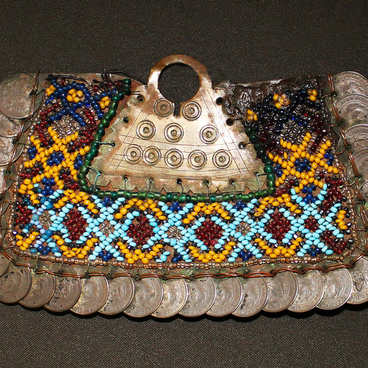The collection of the Museum named after Stepan Erzya is large and varied. Among all the items on display, the Mordovian bride’s veil, used in wedding ceremonies, is of particular interest. This exhibit is on display in the Hall of Decorative and Applied Art and dates from the 19th and 20th centuries. This veil was found by the museum staff during an expedition in the Kovylkinskiy district in 1983. In the Moksha language it is called “vertolda” or “velhterda”.
The shawl-cover is a large rectangular cloth sewn from white linen homespun canvas. According to the ancient custom, a vertolda was embroidered by the bride and her friends. On each of the strips there were two (on one strip — three) rosettes of different shape and pattern, symbolizing the solar sign. There had to be an odd number of rosettes, starting with seven. One of the nine rosettes on this veil differs significantly from the others in size and is located at a distance from the others. Perhaps this can be explained by the fact that it was made by the bride herself, and because of the busy period before the wedding there was no time to embroider a large size. The decorative pattern of embroidery is geometric, made with red woolen threads with yellow and green flecks. There is also a black line and dot border.
Covering a bride’s head in the history of the Mordovian people goes back centuries. It was believed that during the passage from the parental home to the husband’s family, a girl is subject to the influence of evil spirits. Wedding rites described the symbolic death of the bride and her rebirth as a woman. Vertolda was supposed to protect her from the evil eye and spoilage on her wedding day. It was believed that embroidered patterns enhanced the magical functions of the veil. This tradition survived until the early 20th century. Embroidered veils were replaced by factory-made silk shawls with long fringes around the edges.
A cover with 13 rosettes, made by Mordovian craftswomen from the village of Boldovo (now Ruzaevsky district of the Republic of Mordovia), is in one of the museums in Helsinki. The vertolda wedding cover is a true example of the talent of Mordovian embroiderers, which to this day allows us to get in touch with the rich traditions of the Mordovian people.
The shawl-cover is a large rectangular cloth sewn from white linen homespun canvas. According to the ancient custom, a vertolda was embroidered by the bride and her friends. On each of the strips there were two (on one strip — three) rosettes of different shape and pattern, symbolizing the solar sign. There had to be an odd number of rosettes, starting with seven. One of the nine rosettes on this veil differs significantly from the others in size and is located at a distance from the others. Perhaps this can be explained by the fact that it was made by the bride herself, and because of the busy period before the wedding there was no time to embroider a large size. The decorative pattern of embroidery is geometric, made with red woolen threads with yellow and green flecks. There is also a black line and dot border.
Covering a bride’s head in the history of the Mordovian people goes back centuries. It was believed that during the passage from the parental home to the husband’s family, a girl is subject to the influence of evil spirits. Wedding rites described the symbolic death of the bride and her rebirth as a woman. Vertolda was supposed to protect her from the evil eye and spoilage on her wedding day. It was believed that embroidered patterns enhanced the magical functions of the veil. This tradition survived until the early 20th century. Embroidered veils were replaced by factory-made silk shawls with long fringes around the edges.
A cover with 13 rosettes, made by Mordovian craftswomen from the village of Boldovo (now Ruzaevsky district of the Republic of Mordovia), is in one of the museums in Helsinki. The vertolda wedding cover is a true example of the talent of Mordovian embroiderers, which to this day allows us to get in touch with the rich traditions of the Mordovian people.


